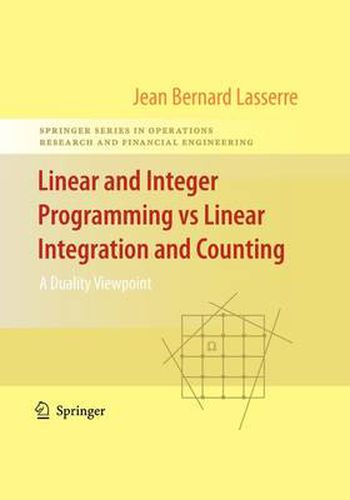Readings Newsletter
Become a Readings Member to make your shopping experience even easier.
Sign in or sign up for free!
You’re not far away from qualifying for FREE standard shipping within Australia
You’ve qualified for FREE standard shipping within Australia
The cart is loading…






This title is printed to order. This book may have been self-published. If so, we cannot guarantee the quality of the content. In the main most books will have gone through the editing process however some may not. We therefore suggest that you be aware of this before ordering this book. If in doubt check either the author or publisher’s details as we are unable to accept any returns unless they are faulty. Please contact us if you have any questions.
Integer programming (IP) is a fascinating topic. Indeed, while linear programming (LP), its c- tinuous analogue, is well understood and extremely ef?cient LP software packages exist, solving an integer program can remain a formidable challenge, even for some small size problems. For instance, the following small (5-variable) IP problem (called the unbounded knapsack problem) min{213x?1928x?11111x?2345x +9123x} 1 2 3 4 5 s.t. 12223x +12224x +36674x +61119x +85569x = 89643482, 1 2 3 4 5 x ,x ,x ,x ,x?N, 1 2 3 4 5 taken from a list of dif?cult knapsack problems in Aardal and Lenstra [2], is not solved even by hours of computing, using for instance the last version of the ef?cient software package CPLEX. However,thisisnotabookonintegerprogramming,asverygoodonesonthistopicalreadyexist. For standard references on the theory and practice of integer programming, the interested reader is referred to, e.g., Nemhauser and Wolsey [113], Schrijver [121], Wolsey [136], and the more recent Bertsimas and Weismantel [21]. On the other hand, this book could provide a complement to the above books as it develops a rather unusual viewpoint.
$9.00 standard shipping within Australia
FREE standard shipping within Australia for orders over $100.00
Express & International shipping calculated at checkout
This title is printed to order. This book may have been self-published. If so, we cannot guarantee the quality of the content. In the main most books will have gone through the editing process however some may not. We therefore suggest that you be aware of this before ordering this book. If in doubt check either the author or publisher’s details as we are unable to accept any returns unless they are faulty. Please contact us if you have any questions.
Integer programming (IP) is a fascinating topic. Indeed, while linear programming (LP), its c- tinuous analogue, is well understood and extremely ef?cient LP software packages exist, solving an integer program can remain a formidable challenge, even for some small size problems. For instance, the following small (5-variable) IP problem (called the unbounded knapsack problem) min{213x?1928x?11111x?2345x +9123x} 1 2 3 4 5 s.t. 12223x +12224x +36674x +61119x +85569x = 89643482, 1 2 3 4 5 x ,x ,x ,x ,x?N, 1 2 3 4 5 taken from a list of dif?cult knapsack problems in Aardal and Lenstra [2], is not solved even by hours of computing, using for instance the last version of the ef?cient software package CPLEX. However,thisisnotabookonintegerprogramming,asverygoodonesonthistopicalreadyexist. For standard references on the theory and practice of integer programming, the interested reader is referred to, e.g., Nemhauser and Wolsey [113], Schrijver [121], Wolsey [136], and the more recent Bertsimas and Weismantel [21]. On the other hand, this book could provide a complement to the above books as it develops a rather unusual viewpoint.